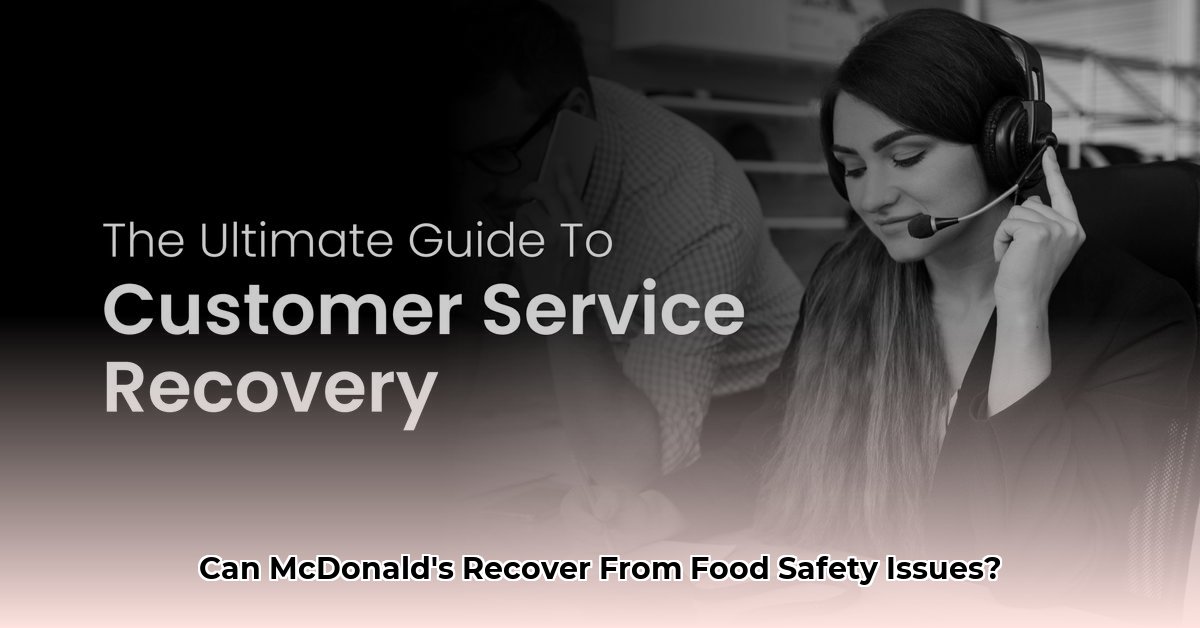How McDonald’s Rebounds from Crisis
Food safety is paramount, particularly for industry giants like McDonald’s. Incidents like the 2024 Quarter Pounder scare and the subsequent E. coli outbreak underscore the fragility of consumer trust. This analysis delves into McDonald’s customer recovery strategies, examining specific incidents, their responses, and the long-term impact.
Case Study: The 2024-2025 E. coli Outbreak
This incident provides a valuable lens through which to examine McDonald’s crisis management. Contaminated onions from supplier Taylor Farms triggered a multi-state outbreak, significantly impacting consumer confidence and sales.
Timeline of Events
| Date | Event |
|---|---|
| October 2024 | Reports emerge linking an E. coli outbreak to McDonald’s. |
| October 2024 | McDonald’s identifies contaminated onions from Taylor Farms. |
| Oct/Nov 2024 | Affected menu items removed; $100 million recovery plan launched. |
| November 2024 | Value meals introduced (e.g., $5 meal deal, Chicken Big Mac). |
| Nov/Dec 2024 | Targeted marketing campaigns launched (e.g., Collector’s Cups, Crocs partnership). |
This timeline suggests a proactive, swift response was implemented, possibly mitigating further damage.
The $100 Million Recovery Plan
This substantial investment demonstrated a commitment to rectifying the situation and rebuilding trust. The funds were allocated to:
- Product Removal: Immediate removal of contaminated onions.
- Value Promotions: Incentivizing customer returns through value meals and special offers.
- Targeted Marketing: Re-engaging customers through promotional campaigns and brand partnerships.
This multifaceted approach likely aimed to address both immediate concerns and long-term brand perception.
Evaluating the Response
Initial sales declines were inevitable. However, the subsequent gradual increase in customer visits suggests the recovery plan may have been effective. Further data analysis is required to definitively determine its success.
Comparing McDonald’s and Chipotle
Both chains have faced E. coli outbreaks. McDonald’s arguably took a more immediate, focused approach, rapidly identifying the source and implementing a comprehensive plan. Chipotle, while ultimately successful took a different, arguably slower, tack. This comparison highlights the potential advantages of a proactive, well-defined recovery strategy. Further research could illuminate the nuances of each approach and reveal best practices.
Long-Term Impact and Untapped Potential
The long-term impact on McDonald’s brand reputation and customer loyalty requires ongoing observation. While initial recovery is promising, sustained efforts are crucial. This area presents untapped potential for further research, exploring the nuances of brand resilience and consumer forgiveness. Ongoing research may also consider the impact of similar crises on long-term profitability across industry, competitor, and product lines.
Case Study: The 2018 “Quarter Pounder Scare” (Hypothetical Example)
This fictional scenario explores a hypothetical incident involving foreign objects found in Quarter Pounders. It serves as a framework for analyzing potential recovery strategies.
Incident: Contaminated Quarter Pounders (Hypothetical)
Let’s imagine reports surface of plastic fragments in Quarter Pounders across several locations.
McDonald’s Hypothetical Response
- Immediate Actions: Public acknowledgment of the issue, temporary suspension of sales, and launch of an internal investigation.
- Recovery Strategy: Product recall, enhanced quality control measures, customer refunds, and collaboration with an independent food safety auditor.
- Communication: Transparent updates to the public and stakeholders, emphasizing commitment to safety and corrective actions.
Measuring Impact (Hypothetical)
- Sales Data: Tracking sales at affected locations to assess immediate consumer response.
- Customer Surveys: Gauging customer satisfaction with the recovery efforts.
- Social Media Sentiment Analysis: Monitoring online conversations to understand public perception.
This hypothetical scenario underscores the importance of a rapid, transparent, and comprehensive response. It also provides a framework for analyzing the effectiveness of specific recovery tactics.
Additional Crisis Scenarios & Competitive Analysis
Consider these additional (hypothetical) scenarios:
- Scenario 2: Undercooked Chicken McNuggets lead to localized incidents of foodborne illness.
- Scenario 3: A social media campaign backfires, leading to widespread negative publicity.
By applying the analytical framework used in the previous scenarios, we can explore the potential effectiveness of various recovery strategies. Furthermore, comparing McDonald’s approach to competitors like Burger King and Wendy’s, facing similar hypothetical situations, provides insights into industry best practices. This comparative analysis may reveal the relative strengths and weaknesses of different recovery approaches.
Root Cause Analysis: Contributing Factors
Beyond reacting to crises, understanding their potential root causes is crucial. Some possible contributing factors to service disruptions at McDonald’s:
- Franchise Model: Decentralized operations can create inconsistencies in service and quality control, potentially leading to variations in incident occurrence and recovery.
- Extensive Menu: A large menu can create operational complexities, increasing the likelihood of errors and impacting customer satisfaction.
- Food Quality Perception: Perceptions of food quality can influence customer tolerance for service issues. Addressing quality concerns may improve overall resilience to disruptions.
These factors represent potential areas for improvement and further research. Understanding their interplay can inform more effective preventative measures.
McDonald’s Response Strategies: A Deeper Dive
McDonald’s response to crises extends beyond immediate actions. Their strategies encompass a range of approaches:
- Financial Support for Franchisees: This demonstrates a commitment to the entire McDonald’s ecosystem and likely mitigates long-term financial instability within the franchise network.
- Menu Adjustments and New Product Launches: This proactive approach can revitalize customer interest and rebuild confidence.
- Emphasis on “Doing the Right Thing”: While financial investments are vital, prioritizing customer satisfaction and actively seeking feedback strengthens the customer relationship.
- Employee Empowerment: Training frontline staff to effectively handle complaints can significantly enhance customer recovery efforts.
- Enterprise-Wide Risk Management (ERM): This comprehensive framework allows McDonald’s to anticipate, evaluate, and address various risks, improving preparedness for future challenges.
Measuring Recovery Impact: A Multifaceted Approach
Assessing the true impact of recovery strategies requires a holistic view. Key metrics include:
- Post-Incident Customer Satisfaction: Measured through surveys and feedback mechanisms.
- Social Media Sentiment: Tracked through social listening tools.
- Complaint Resolution Time: Monitored through internal tracking systems.
- Long-Term Brand Perception: Observed through ongoing market research and customer behavior analysis.
These metrics provide a more nuanced understanding of recovery effectiveness and inform future strategies.
Conclusion: Ongoing Learning and Adaptation
McDonald’s customer recovery strategies demonstrate a blend of immediate actions, long-term planning, and a commitment to continuous improvement. The company’s approach provides a valuable case study for businesses across industries. However, the fast-food landscape is ever-evolving, and ongoing research is essential to refine recovery strategies and maintain customer trust in a dynamic environment.
- Water Mill Electricity Generator Provides Free Home Power - December 16, 2025
- Water Wheel Electric Generator Provides Free Home Electricity - December 15, 2025
- Choosing the Right Portable Hydro Turbine for Your Needs - December 14, 2025
















